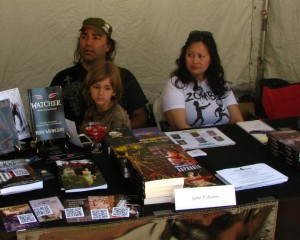“Happiness In Slavery: On Chris Kelso’s A MESSAGE FROM THE SLAVE STATE”
by Edward Morris
Joseph Perry, ed. Book Cover Design By D.T. Griffith Interior Design
By Stephen Tallarico
Western Legends Press, 2013
http://www.facebook.com/WesternLegendsPress
From the first paragraphs of the first page of A MESSAGE FROM THE SLAVE STATE, the Sheckleyan principle of Psychology Trumping Technology is illustrated. Only at the end of the last paragraph do we learn the year. The head in a bag Your Humble Narrator finds on page One is taken as mere par for the course, and the duty-cop in the second scene really is the “insect” he is described as.
Then the fun starts… And there I begin to self-apply Duct Tape to my mouth about the actual story. Because it has to be encountered.
What the reader takes as metaphor in Chris’ work is, often, far stranger and deeper than mere description. Every chapter of this work is in a different voice, pace and key, and they all fit. They all work. I barely want to explain any of the plot, because it has to be encountered, like a ranting homeless brain-case who suddenly makes more sense than anyone you ever met, when you actually listen. The tale that this street-Tiresias tells is suddenly a whole world, to you, one which mirrors the unendurable present in inarguable language.
The commonplace is twisted through a funhouse mirror into utter, enduring awfulness, while the awful has become commonplace in the Dystopia of this story. Even the quasi-linear beginning brutally twists into a junk-fueled urban jungle of a vast dictatorship whose every cog and gear answers to no rules but its own. Every one of those disparate parts moves the larger picture of the story along with a skyrocketing speed and technical skill that takes a good few reads to fully fathom.
Further, what should be funny becomes horrible, and many of the most horrible parts are bleakly hilarious. As a bouncer, the scene with Danny Smear yelling, “I HAVE A FACE!! LOOK AT IT!!!” to the entire crowd had me in near-tears of laughter, though the scene around it had me anywhere but. I knew I shouldn’t laugh. I couldn’t help it. Many more such exemplary incongruities abound… to say nothing of the places where the blowtorch of language turns up to a sentence like: “He stepped into the shower, washing off tears too proud to fall.”
No matter what the year, the Slave State is Life. Insanity and Sociopolitics are etched in as different limbs of the same rough beast slouching somewhere of far greater future significance than Bethlehem. In perceiving this pattern, the reader doesn’t necessarily escape it, but realizes their own enmeshment to such a degree that, by the end of this Venn Diagram of a tale, you can See What He Really Did There, crossing the axis from one kind of fiction to the other, from one influence to the other, to tell a meta-tale that both encompasses and reaches beyond each.
People make the comparisons to Burroughs, Bukowski, Dick and Trocchi with Chris’ work, and they’re fair. But there are so many other influences here, in deft interplay. Some writers wear their influences on their sleeves (raises hand)… and some, such as Chris Kelso, juggle with those influences, and weave them into a tapestry with a larger purpose than mere homage.
I was shocked and delighted, for example, to follow the pacing of the patricide scene very early on and realize that I was looking at similar technical tricks used by Cormac McCarthy in SUTTREE (a work I consider at least somewhat Bizarro, although that’s another review.) And the only structure I can compare to this work is one of my favorite pieces in this vein, a radio-play written in the madhouse by Antonin Artaud called “To Have Done With The Judgement Of God.”
This book is to Bizarro what CAT’S EYE, THE ILLUSTRATED MAN or NECRONOMICON are to the film genre: a clockwork of several stories whose larger shape is different than any part, or even the sum of them. You can’t read this book just once. Nor should you.
John Palisano with “A Message from the Slave State” at the LA Times Book Festival, Carlton Mellick III with my book 🙂





